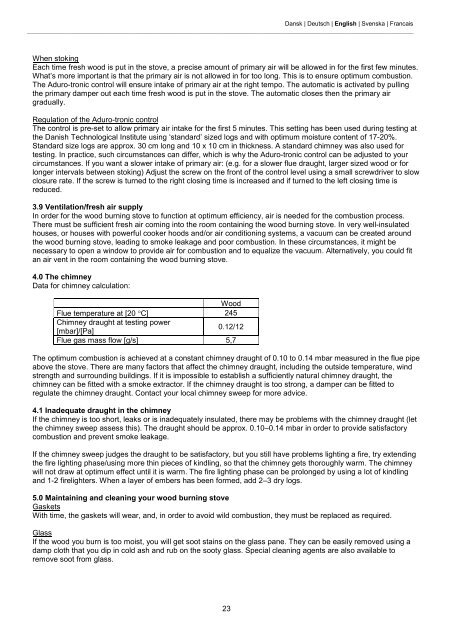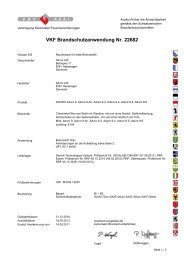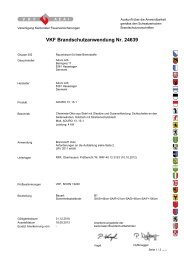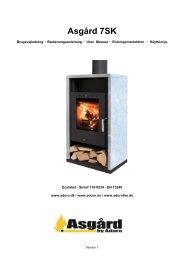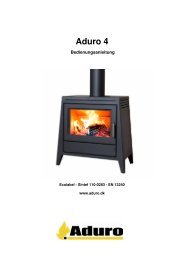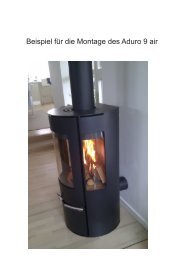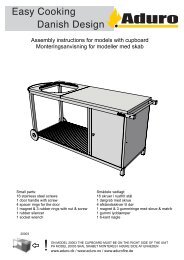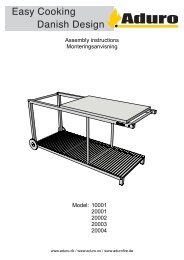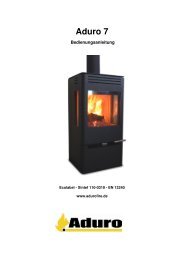Aduro 9 - Cheminées & Feux
Aduro 9 - Cheminées & Feux
Aduro 9 - Cheminées & Feux
You also want an ePaper? Increase the reach of your titles
YUMPU automatically turns print PDFs into web optimized ePapers that Google loves.
Dansk | Deutsch | English | Svenska | Francais<br />
_______________________________________________________________________________________________________________________________<br />
When stoking<br />
Each time fresh wood is put in the stove, a precise amount of primary air will be allowed in for the first few minutes.<br />
What’s more important is that the primary air is not allowed in for too long. This is to ensure optimum combustion.<br />
The <strong>Aduro</strong>-tronic control will ensure intake of primary air at the right tempo. The automatic is activated by pulling<br />
the primary damper out each time fresh wood is put in the stove. The automatic closes then the primary air<br />
gradually.<br />
Regulation of the <strong>Aduro</strong>-tronic control<br />
The control is pre-set to allow primary air intake for the first 5 minutes. This setting has been used during testing at<br />
the Danish Technological Institute using ‘standard’ sized logs and with optimum moisture content of 17-20%.<br />
Standard size logs are approx. 30 cm long and 10 x 10 cm in thickness. A standard chimney was also used for<br />
testing. In practice, such circumstances can differ, which is why the <strong>Aduro</strong>-tronic control can be adjusted to your<br />
circumstances. If you want a slower intake of primary air: (e.g. for a slower flue draught, larger sized wood or for<br />
longer intervals between stoking) Adjust the screw on the front of the control level using a small screwdriver to slow<br />
closure rate. If the screw is turned to the right closing time is increased and if turned to the left closing time is<br />
reduced.<br />
3.9 Ventilation/fresh air supply<br />
In order for the wood burning stove to function at optimum efficiency, air is needed for the combustion process.<br />
There must be sufficient fresh air coming into the room containing the wood burning stove. In very well-insulated<br />
houses, or houses with powerful cooker hoods and/or air conditioning systems, a vacuum can be created around<br />
the wood burning stove, leading to smoke leakage and poor combustion. In these circumstances, it might be<br />
necessary to open a window to provide air for combustion and to equalize the vacuum. Alternatively, you could fit<br />
an air vent in the room containing the wood burning stove.<br />
4.0 The chimney<br />
Data for chimney calculation:<br />
Wood<br />
Flue temperature at [20 °C] 245<br />
Chimney draught at testing power<br />
[mbar]/[Pa]<br />
0.12/12<br />
Flue gas mass flow [g/s] 5,7<br />
The optimum combustion is achieved at a constant chimney draught of 0.10 to 0.14 mbar measured in the flue pipe<br />
above the stove. There are many factors that affect the chimney draught, including the outside temperature, wind<br />
strength and surrounding buildings. If it is impossible to establish a sufficiently natural chimney draught, the<br />
chimney can be fitted with a smoke extractor. If the chimney draught is too strong, a damper can be fitted to<br />
regulate the chimney draught. Contact your local chimney sweep for more advice.<br />
4.1 Inadequate draught in the chimney<br />
If the chimney is too short, leaks or is inadequately insulated, there may be problems with the chimney draught (let<br />
the chimney sweep assess this). The draught should be approx. 0.10–0.14 mbar in order to provide satisfactory<br />
combustion and prevent smoke leakage.<br />
If the chimney sweep judges the draught to be satisfactory, but you still have problems lighting a fire, try extending<br />
the fire lighting phase/using more thin pieces of kindling, so that the chimney gets thoroughly warm. The chimney<br />
will not draw at optimum effect until it is warm. The fire lighting phase can be prolonged by using a lot of kindling<br />
and 1-2 firelighters. When a layer of embers has been formed, add 2–3 dry logs.<br />
5.0 Maintaining and cleaning your wood burning stove<br />
Gaskets<br />
With time, the gaskets will wear, and, in order to avoid wild combustion, they must be replaced as required.<br />
Glass<br />
If the wood you burn is too moist, you will get soot stains on the glass pane. They can be easily removed using a<br />
damp cloth that you dip in cold ash and rub on the sooty glass. Special cleaning agents are also available to<br />
remove soot from glass.<br />
23


